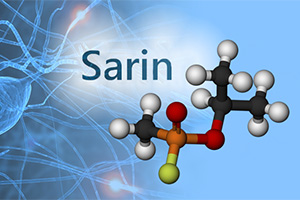Sarin: Potential Long-term Neurological Effects

Topic Overview
Background Information
Sarin is a highly toxic organophosphorus nerve agent that was developed for chemical warfare during World War II and continues to be used as a weapon today. We know that exposure to sarin can result in death, or short-term health effects including seizures, paralysis, and difficulty breathing within 24 hours of exposure.
In contrast, long-term health effects of sarin exposure could be observed days, weeks, or years after exposure. Although there are reports of potential long-term neurological effects from sarin exposure, the evidence has not been evaluated with the increased objectivity, rigor, and transparent process of systematic review.
Previous literature reviews of potential long-term health effects of sarin have generally not assessed individual study quality or considered a combination of human, animal, and mechanistic data. In addition, the interpretations of health effects in some of these reviews were confounded by concurrent exposure to multiple chemicals, as may have occurred with military personnel exposed during the Gulf War or other conflicts. This makes it difficult to discern whether health effects observed are from sarin or other chemicals.
To address these limitations, NTP conducted a systematic review to evaluate the evidence of long-term neurological damage from human, experimental animal or mechanistic studies after acute, sub-lethal exposure to sarin. This review was requested by the Countermeasures Against Chemical Threats (CounterACT) program at the National Institutes of Health, and used the definition of long-term neurological damage as symptoms observed or reported more than 24 hours after exposure.
Hazard conclusions were developed for three time periods after exposure to sarin. NTP concludes that acute sarin exposure is known to be a neurological hazard to humans in the initial time period of greater than 24 hours–7 days after exposure based on suppression of cholinesterase. NTP also concludes that acute sarin exposure is suspected to be a neurological hazard to humans in both the intermediate and extended time periods from 8 days to years after exposure based on multiple neurological effects.
Documents
| Date | Document |
|---|---|
| Apr 01, 2017 | NTP Protocol |
| Mar 15, 2018 | Literature Search Results |
| Jun 01, 2019 | NTP Monograph - Final (Abstract) Preferred Citation: National Toxicology Program (NTP). 2019. NTP monograph on the systematic review of long-term neurological effects of sarin. Research Triangle Park, NC: National Toxicology Program. NTP Monograph 06. https://doi.org/10.22427/NTP-MGRAPH-6 |
Meetings & Events
| Date | Event | Event Type | Materials |
|---|---|---|---|
| Feb 04, 2019 | Peer Review of the Draft NTP Monograph on the Systematic Review of Evidence of Long-Term Neurological Effects Following Acute Exposure to the Organophosphorus Nerve Agent Sarin |
Expert Panels - NTP Monographs |
|
| Jun 17, 2019 | NTP Board of Scientific Counselors Meeting |
Board of Scientific Counselors - BSC Meeting |
|
Note on Accessibility: Persons with disabilities or using assistive technology may find some documents are not fully accessible. For assistance, email us or use our contact form and identify the documents/pages for which access is required. We will assist you in accessing the content of these files. NIEHS has helpful information on accessibility.
Note on Accessibility: Persons with disabilities or using assistive technology may find some documents are not fully accessible. For assistance, email us or use our contact form and identify the documents/pages for which access is required. We will assist you in accessing the content of these files. NIEHS has helpful information on accessibility.

